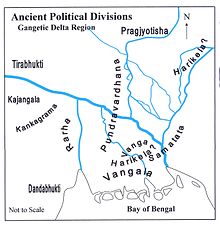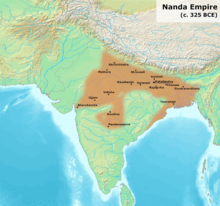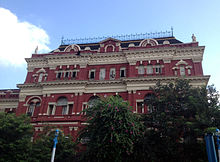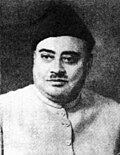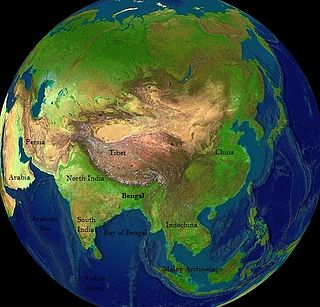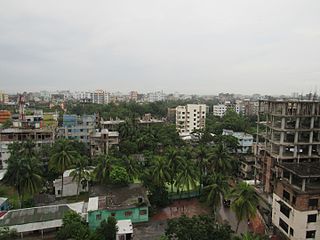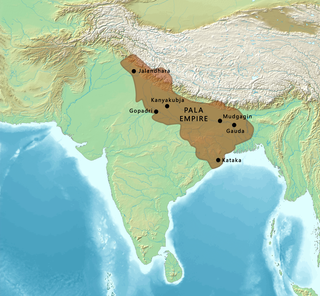This article has multiple issues. Please help improve it or discuss these issues on the talk page . (Learn how and when to remove these template messages)
|
| History of Bengal |
|---|
 |
| Part of a series on |
| Bengalis |
|---|
 |
This is a list of rulers of Bengal. For much of its history, Bengal was split up into several independent kingdoms, completely unifying only several times. In ancient times, Bengal consisted of the kingdoms of Pundra, Suhma, Vanga, Samatata and Harikela.
Contents
- Ancient Bengal
- Ancient geopolitical divisions
- Anga kingdom (c. 1100 – 530 BCE)
- Vanga kingdom (c. 1100 – 340 BCE)
- Pundra kingdom (c. 1100 – 340 BCE)
- Suhma kingdom (c. 1100 – 340 BCE)
- Videha dynasty of Mithila (Tirabhukti) (c. 1100 – 700 BCE)
- Gangaridai kingdom (c. 350 – 100 BCE)
- Magadha dynasties of Bengal
- Brihadratha dynasty (c. 1700 – 682 BCE)
- Pradyota dynasty (c. 682 – 544 BCE)
- Haryanka dynasty (c. 544 – 413 BCE)
- Shishunaga dynasty (c. 413 – 345 BCE)
- Nanda Empire (c. 345 – 322 BCE)
- Maurya Empire (c. 322 – 184 BCE)
- Shunga Empire (c. 185 – 73 BCE)
- Kanva dynasty (c. 73 – 28 BCE)
- Classical Era
- Chandra dynasty (c. 202 – 1050 CE)
- Gupta Empire (c. 240 – 550 CE)
- Jaintia kingdom (c. 525 – 1835 CE)
- Gauda kingdom (c. 550 – 626 CE)
- Pushyabhuti (Vardhana) Empire (c. 606 – 647 CE)
- Khadga dynasty (c. 625 – 730 CE)
- Bhadra dynasty (6th to 7th century)
- Mallabhum kingdom (c. 694 – 1147 CE)
- Post-Classical era
- Pala Empire (c. 750 – 1161 CE)
- Sena dynasty (c. 1070 – 1230 CE)
- Deva dynasty (c. 1150 – 1294 CE)
- Delhi Sultanate period
- Khalji dynasty
- Governors of Bengal under Mamluk dynasty (1227–1287)
- House of Balban
- Governors of Bengal under Tughlaq dynasty (1324–1338)
- Bengal Sultanate era
- Independent Sultans of Bengal during Tughlaq dynasty (1338–1352)
- Ilyas Shahi dynasty (1352–1414)
- House of Raja Ganesha (1414–1435)
- Restored Ilyas Shahi dynasty (1435–1487)
- Habshi rule (1487–1494)
- Hussain Shahi dynasty (1494–1538)
- Governors of Bengal under Sur Empire (1532–1556)
- Muhammad Shah dynasty (1554–1564)
- Karrani dynasty (1564–1576)
- Mughal Subahdars of Bengal Subah (1574–1717)
- During the reign of Akbar
- During the reign of Jahangir
- During the reign of Shah Jahan
- During the reign of Aurangzeb
- Medieval Hindu dynasties of Bengal
- Koch dynasty (c. 1515 – 1949 CE)
- Kingdom of Bhurshut (c. 16th–18th century)
- Kingdom of Chandradweep Or Basu Dynasty
- Maharajas of Jessore region
- Maharaja of Lower Bengal region
- Maharaja of Bhawal region
- Nawabs of Bengal
- Independent Nawabs of Bengal (1717–1757 CE)
- Nawabs of Bengal under East India Company (1757–1838 CE)
- Nawabs of Murshidabad
- East India Company governors in Bengal
- Governors of British East India Company in Bengal (1757–1793)
- Governors-General of British East India Company in Bengal – Dual government (1773–1774)
- Governors-General of British East India Company in Bengal (1793–1854)
- Governor-Generals of British East India Company (1833–1858)
- British Raj era
- Lieutenant-Governors (1858–1912)
- Governors (1912–1947)
- Prime Minister of Bengal (1937–1947)
- After Independence of India and Pakistan
- Pakistani (East) Bengal (1947–1971)
- Indian (West) Bengal (1947–present)
- After independence of Bangladesh
- Key
- Presidents of Bangladesh
- Prime Ministers of Bangladesh
- See also
- Notes
- References
- Sources
In the 4th century BCE, during the reign of the Nanda Empire, the powerful rulers of Gangaridai sent their forces with the war elephants which led the withdrawal of Alexander the Great from the Indian subcontinent. [1]
With the rise of Gopala in 750 AD, Bengal was united once more under the Buddhist and Shaivite Pala Empire. The Pala period is considered as one of golden eras of Bengali history as it brought stability and prosperity to Bengal after centuries of Civil War, created outstanding works of art and architecture, proto-Bengali language develop under them including its first literary work, the Charyapada and so on. Until the 12th century than being succeeded by the Buddhist and Hindu Chandra dynasty, Sena dynasty and Deva dynasty. The rule of deva dynasty was a period of peace, prosperity and creative excellence and may be designed as "golden age" After them, Bengal was ruled by the Hindu Maharajas of kingdoms such as Chandradwip and Cooch Behar.[ citation needed ]
In the early 13th century, Muhammad bin Bakhtiyar Khalji conquered Western and part of Northern Bengal, [2] and established the first Muslim kingdom in Bengal. [3] The Islamic Mamluk Sultanate, the Khalji dynasty, the Turko-Indian Tughlaq dynasty, the Sayyid dynasty and the Lodi dynasty ruled Bengal for over 320 years. [4] Notable was Malik Altunia's reign with his wife Razia Sultana, the only female sovereign ruler.[ citation needed ]
Following Delhi Sultanate's reign, the Bengal Sultanate, a major trading nation in the world, [5] was founded by Shamsuddin Ilyas Shah, and ruled by the Ilyas Shahi dynasty, succeeded by the Hussain Shahi dynasty founded by Alauddin Husain Shah, which saw the extension of the sultanate to the port of Chittagong, witnessing the arrival of the earliest Portuguese merchants.[ citation needed ]
